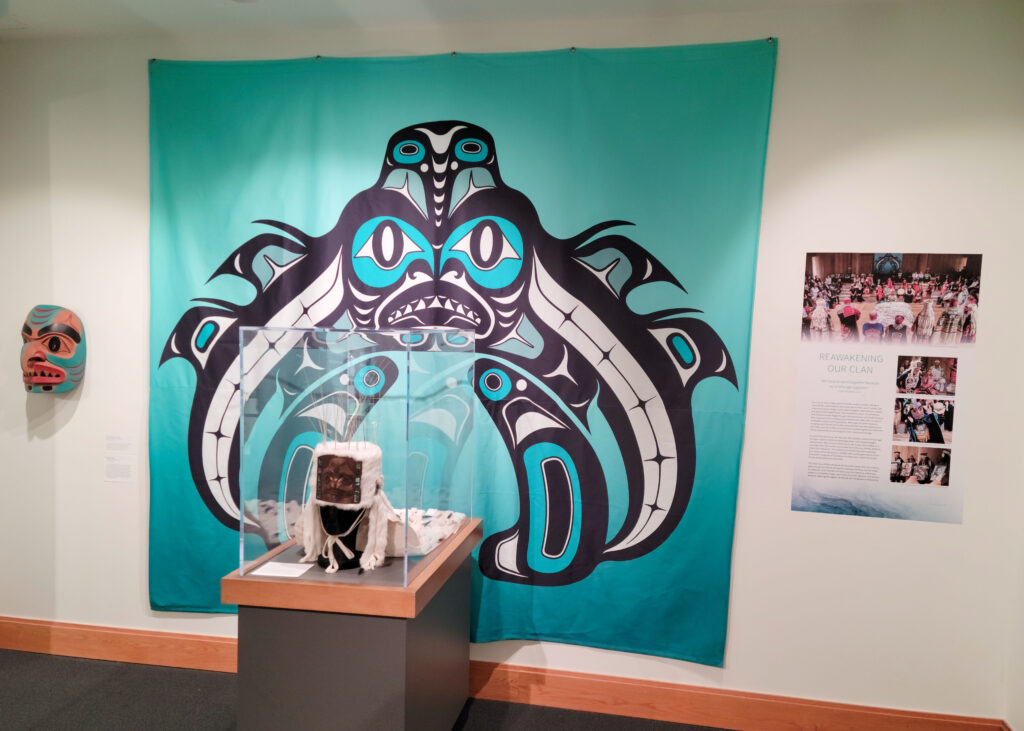By: Kelly Chia, Editor-in-Chief
One of the featured artists in the newly opened The Art of Dimension exhibit, Skii Xaaw Jesse Brillon, writes that repoussé is a method of art where you hammer out metal from the inside. You can see that in the elements around each curve in Jesse’s hammerwork: the details of each facial wrinkle convey stories and folklore. Jesse’s art is displayed alongside his niece’s, Haaylingtso Marlo Wylie Brillon, who debuts her art in this exhibit in the Bill Reid Gallery of Northwest Coast Art. Marlo has been working in textiles since a young age, but credits learning how to create original Haida art to her uncle. Marlo’s sculptural works, rendered and sculpted in cedar, reflect her close relationship to Jesse as her artistic mentor. The selected carvings in this exhibit call to their experiences and stories.
As I walked into this exhibit, I was drawn to the intense expression on a silver bracelet Jesse had named, “‘WaasGo & The Three Fishermen Bracelet.” Jesse describes ‘WaasGo as a supernatural figure. It’s part-wolf, part-whale — and you can see these features carved in the large wolfy ears and lips adorning the front of the bracelet. ‘WaasGo is known to “sometimes capsize canoes.” Jesse wrote on the bracelet’s plaque that he and the Martynuik brothers were shipwrecked on Banks Island in 2012. The trio were forced to subsist themselves on clams and seaweed for eight days awaiting rescue. He carves and represents the small group above ‘WaasGo’s ears, caught in roaring waves. Stories like this persist through Jesse’s other featured works in the exhibit, expertly carved with stunning abalone inlay, which shines iridescently against silver and gold.

These stories persist, too, in the cedar works Marlo had carved. A particularly evocative piece, called “Kalga Jaad and Xuuya,” features a woman with a serene, maternal expression, breastfeeding a raven. She was beautiful: I couldn’t help staring at the grooves in the aged red cedar, the calm look in Kalga Jaad’s eyes as she looked on benevolently. Marlo wrote that she had based this piece on the “story of Kalga Jaad soothing the fussy Raven by breastfeeding them to keep them quiet and calm.
“The story resonated with me for two reasons, one is that my mother and great-grandmother’s name is Kalga Jaad. While this name has been passed down over generations through our matrilineal line, I also feel the story of Kalga Jaad conveys beautiful imagery and captures a moment that highlights the role of women in motherhood,” she wrote. Marlo dedicates this piece to her uncle, Jesse, her partner, Karver Everson, and her step-father, Andy Everson, thanking and acknowledging the matrilineal Laana Tsaadas clan for guiding her continual work in upholding their culture.
On a larger scale, this piece, through retelling Kalga Jaad and the Raven’s story, exemplifies Indigenous connection through storytelling in art. Bill Reid, the Haida artist that the gallery is named after, is a member of the Raven clan. He was often compared to the Raven, who he’d describe as a “mischievous trickster, [playing] an important part in transforming the world,” and would receive the Haida name, Yaahl Sgwansung, in 1986: “The Only Raven.” The Raven’s mischievous expression in Marlo’s piece made me think of Reid, whose artistic influence is evident in the works displayed in the gallery.
The Art of Dimension showcases Indigenous storytelling by Jesse and Marlo’s impressive carving work and art, as well as their appreciation and connection to one another. It is open to the public from July 4–October 15, and the gallery is free to Indigenous peoples, and SFU students and if they provide ID. Tickets are otherwise $13 for adults.